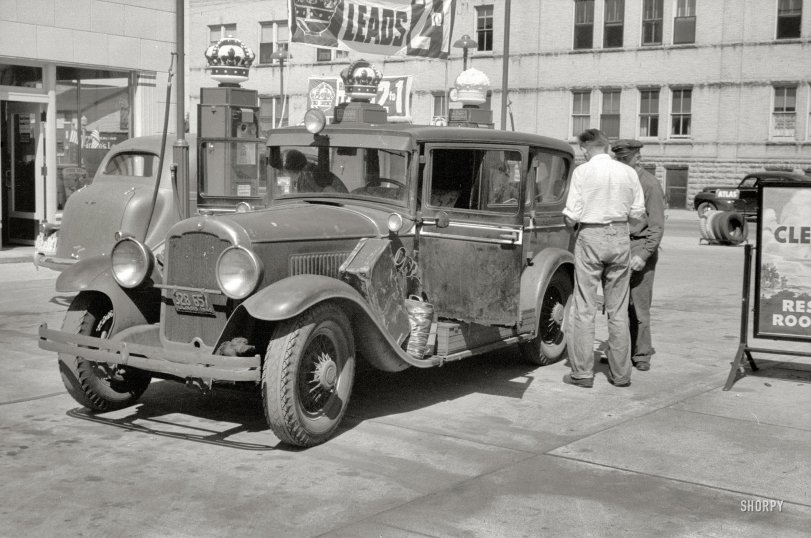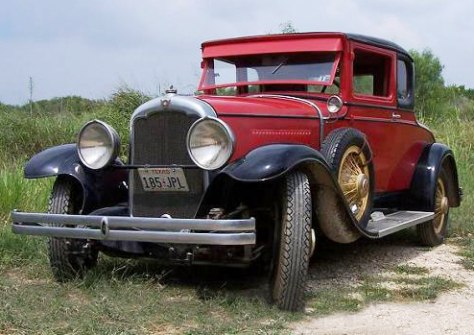


Framed or unframed, desk size to sofa size, printed by us in Arizona and Alabama since 2007. Explore now.
Shorpy is funded by you. Patreon contributors get an ad-free experience.
Learn more.

- Icing Platform?
- Indiana Harbor Belt abides
- Freezing haze
- Corrections (for those who care)
- C&NW at Nelson
- Fallen Flags
- A dangerous job made worse
- Water Stop
- Passenger trains have right of way over freights?
- Coal
- Never ceases to amaze me.
- Still chuggin' (in model form)
- Great shot
- Westerly Breeze
- For the men, a trapeze
- Tickled
- Sense of loneliness ...
- 2 cents
- Charm City
- What an Outrage
- Brighton Park
- Catenary Supports
- Just a Little Before I was Born
- Afternoon normal
- The Flat Iron Cafe survives
- Aging in Place
- Raise your hand
- Good and Bad
- Oh, the 70's
- Nooooooi
Print Emporium
Old Reliable: 1940

July 1940. "Auto of migrant fruit worker at gas station in Sturgeon Bay, Wisconsin." The other end of the jalopy we saw here. 35mm nitrate negative by John Vachon for the Farm Security Administration. View full size.
Information, Please
The beauty of Shorpy demonstrated again: info about the REO, the gas pumps, and proof that, at this location at least, it's still business as usual. Great.
Beautiful Cars; Not Always Loved
Properly maintained, the cars from that era would last a long time (lots are still around today). Only problem is, most weren't maintained. Parts were very easy to change out though. Today's cars last longer without extensive maintenance, but when it's time to replace parts, you almost have to leave it to the dealer. I'd take a '20s to '60s car anyday over todays.
Door damage
The lower edge of the driver's door is an odd place for a "rust out" to occur on this car. I'll bet that storage box inconveniently stuck onto the running board had something to do with the damage.
Don't make 'em like they used to
Thank goodness! Cars didn't last as long back then. many DID, but things wore out. The horrible roads during the Great Depression added to the demise of many ten to fifteen year old cars. Cars would literally be shaken apart by the washboard-like conditions of most of the main thoroughfares. If everything wasn't lubed regularly, parts seized up and ceased to function.
family owned?
Standard Oil became Amoco which was gobbled up by BP.
If it's a BP today, it might have been the same franchise for over 70 years.
Other Car
Is that other car at the pump a 1936 Dodge? Sure looks like the one my folks had.
Love those glass crowns
Being someone who is dazzled by beautiful, shiny, unusual, kitschy, unique and long-gone items, I wish I had those crowns. Even in my massive collection of the good, the bad and the ugly in both functional and useless items piled high in my garage, I have nothing this spectacular and these especially stunning crowns would be on display in my good living room (if I had them). If that driver's pants have a buckle in the back, they were revived in the 1950's in my high school years as "ivy league pants", very cool, especially in charcoal gray flannels with pink oxford shirts. Daddio!
I'll give you $80 for your jalopy, mister
Okay, I'll grant you that the lower edge of the driver door has seen better days and that glob of dirt and grease to the right of the radiator doesn't thrill, but jalopy? Heck, it's only an 11 year old car if it is a 1929 REO in 1940. That's the equivalent of a 2001 model getting gas today. Would you look twice if a 2001 car were on the road next to you today?
The cost of gas in 1940 averaged 11 cents a gallon. A new 1940 model car was around $850.
The rust out on the door suggests that the rear end customizing may have been done as a home repair for rusted out sheet metal in that area.
If you can just find the entrance to the time machine, I will gladly go back there and pay the owner double the 1940 Kelly Blue Book value on that vehicle right now, rusty door and all, and park it in my 2012 driveway.
So much for progress
Just try stowing a suitcase on your fender now!
The car
is a circa 1929 REO Flying Cloud. Pictured here are a sedan and coupe. The REO Motor Car Co. was founded in 1905 by Ransom E. Olds after he left Oldsmobile (which he also founded.) REO produced both cars and trucks and became Diamond-REO Trucks, Inc. in 1967. The company went out of business in 1975.

Still a gas station
Looks like it's still in use as a gas station:
View Shorpy Sites in a larger map
Standard Oil (Indiana)
These Standard Oil Stations featured "Red","Blue" and rarely "White" Crown which were Ethyl (premium), Regular. Not sure whether the White was Kerosene or non-leaded gasoline.
Stations were in all midwestern states except Ohio where in some areas Standard of Indiana was branded Amoco and used different grade names.
The building shown had porcelain coated steel siding indicating that it was the latest style for that time.
The "homemade" modifications to the old sedan shows consideration by the owner for family comfort for what was still very much the "Depression".
Red, White,and Blue
The "Red Crown" was Standard Oils brand for Hi test(with Ethyl) gasoline. Our subject was no doubt buying the cheaper White Crown. Blue Crown was Standard's name for kerosene for heating use.
I Almost Forgot
I had almost forgot that there were once people who pumped gas for you, and most cleaned the windshield and checked the tires too.
How much I owe you?
I filled er up mister, that'll be ninety five cents.
Oops!
I stand corrected on the June 7 photo of the back end of this rig. Not a Model B after all. I still think I'm right about the homemade addition, however.
Red Crown Gas Station
It's hard to make out the station name from this picture, but with a little searching I learned this is a Red Crown Gas Station. The crowns on the pump were glass globes colored red and white. Please don't touch.
























On Shorpy:
Today’s Top 5